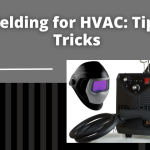Copper nickel, also known as cupronickel, is a popular material for tig welding due to its high resistance to corrosion and wear. However, welding copper-nickel can be challenging due to its high thermal conductivity and the tendency for the material to crack.
TIG welding is a popular choice for welding copper nickel. This material is commonly used in various applications due to its high resistance to corrosion and excellent conductivity. However, TIG welding copper-nickel can be challenging due to the material’s high thermal conductivity and tendency to warp and crack. To achieve successful, high-quality welds on copper-nickel, it’s important to follow certain tips and guidelines.

Tig Welding Copper Nickel
This guide will provide tips and techniques for successfully tig welding copper-nickel, including how to choose the right filler material and how to properly prepare the material for welding. By following these guidelines, you can achieve strong and durable welds on copper-nickel projects.
Choose The Right Tig Welder And Settings
One of the key factors in successful TIG welding of copper-nickel is choosing the right TIG welder and settings. An AC/DC TIG welder is recommended for copper-nickel, as it can weld alternating current (AC) and direct current (DC) materials. It’s also important to choose a welder with an appropriate amperage range for the thickness of the material you will be welding.
Using a foot pedal or hand control to adjust the arc’s heat can also be helpful when TIG welding copper-nickel, as it allows for precise control and can help prevent warping and cracking. Experiment with different settings to find the right balance of heat and speed for your specific project.
Use The Right Filler Rod
Using the right filler rod is another important factor in successful TIG welding of copper-nickel. A copper-nickel filler rod is recommended for TIG welding copper-nickel, as it helps to ensure that the weld is strong and has the same alloy as the base material. Avoid using a filler rod made from a different alloy, as it may provide a different strength and corrosion resistance level.
Preheat The Material
Due to its high thermal conductivity, copper-nickel can be prone to warping and cracking when TIG welded. To reduce the risk of these issues, it’s a good idea to preheat the material before welding. This can reduce stress on the material and ensure a stronger, more reliable weld.
When preheating copper-nickel, it’s important to use low heat and a slow cooling process to prevent stress on the material. This can be achieved by using a low amperage setting and allowing the material to cool naturally after welding.
Clean The Base Material
Before TIG welding copper-nickel, it’s important to clean the base material to remove any oxide or contaminants. This can be done using a stainless steel wire brush or grinder. Cleaning the base material helps to ensure that the weld will be strong and free of defects.
Use Proper Technique
Proper technique is crucial when TIG welding copper-nickel. Keep the tungsten sharp and clean to ensure a consistent arc and a strong weld. Use a long, sweeping motion with the torch to avoid overheating the material and causing warping or cracking. Maintain a consistent arc length to ensure the weld is even and strong.
Use Proper Shielding Gas
To ensure a successful TIG weld on copper-nickel, it’s important to use the proper shielding gas. Argon is the most commonly used gas for TIG welding copper-nickel, as it helps to protect the weld from contamination and provides a stable arc. Use a high-purity grade of argon for best results.
Practice Proper Post-weld Cleaning
After TIG welding copper-nickel, it’s important to clean the weld to remove any oxide or contaminants. A stainless steel wire brush can remove any oxide from the weld, and a copper/nickel-specific cleaner can remove any residue. Proper post-weld cleaning helps to ensure that the weld is strong and corrosion-resistant.
FAQ’s
Is Copper-nickel Hard To Weld?
Copper-nickel alloys can be challenging to weld due to their high thermal conductivity and tendency to crack when subjected to high heat. However, with proper preparation and technique, it is possible to achieve good welds on copper-nickel alloys.
How Do You Weld Copper Nickel?
To weld copper-nickel alloys, the following steps should be followed:
- Clean the workpieces thoroughly to remove any dirt, oil, or other contaminants that may affect the quality of the weld.
- Preheat the workpieces to a temperature of 400-500 degrees Fahrenheit to reduce the risk of hot cracking.
- Use a TIG welding process with a pure tungsten electrode and a shielding gas of argon.
- Use a lower current and voltage than you would for welding steel to avoid overheating the workpieces.
- Use a stringer bead technique, making multiple passes to build up the weld bead.
- How can hot cracking be avoided when welding copper-nickel alloys?
To avoid hot cracking when welding copper-nickel alloys, the following steps can be taken:
- Preheat the workpieces to a temperature of 400-500 degrees Fahrenheit.
- Use a TIG welding process with a pure tungsten electrode and a shielding gas of argon.
- Use a lower current and voltage than you would for welding steel to avoid overheating the workpieces.
- Use a stringer bead technique, making multiple passes to build up the weld bead.
- Allow the welded joint to cool slowly after welding to reduce the risk of hot cracking.
- What does adding nickel to copper do?
Adding nickel to copper creates a copper-nickel alloy with several beneficial properties. Copper-nickel alloys are known for their high corrosion resistance, making them useful in marine and other corrosive environments. They also have good electrical and thermal conductivity, making them useful in electrical and heat transfer applications. Copper-nickel alloys also have good strength and flexibility, making them suitable for structural applications.
Can You Mix Copper And Nickel?
It is possible to mix copper and nickel to create a copper-nickel alloy. Copper-nickel alloys are commonly used in various applications due to their corrosion resistance, electrical and thermal conductivity, and strength. To create a copper-nickel alloy, the two metals are melted together and cooled to create a solid alloy with the desired properties. Copper-nickel alloys can be created in various compositions by varying the amount of copper and nickel used.
What is the correct temperature of TIG welding?
The correct temperature for TIG welding depends on several factors, such as the type of metal being welded, the thickness of the metal, and the welding technique being used.
In general, TIG welding is a high-precision welding process that requires a higher level of control over the heat input. The recommended welding temperature for TIG welding is typically between 1500-3000 degrees Fahrenheit (815-1649 degrees Celsius). However, the exact temperature will depend on the specific metal being welded and the welding parameters being used.
It is important to note that the temperature should be carefully controlled to avoid overheating, which can cause warping, distortion, or even material failure. Therefore, it is crucial to follow proper welding procedures and techniques and to use appropriate welding equipment and materials to ensure a successful TIG welding process.
What is the travel speed for TIG welding?
As an AI language model, I don’t have personal experiences or beliefs. However, I can provide the following information about the travel speed for TIG welding:
The travel speed for TIG (Tungsten Inert Gas) welding depends on various factors such as the thickness of the metal, the welding current, the filler material, and the joint design. Typically, TIG welding is a slower process than other welding techniques as it requires precision and control.
The recommended travel speed for TIG welding varies between 1-6 inches per minute (IPM), depending on the application. Generally, a slower travel speed is required for thicker materials to ensure proper penetration and heat input, while a faster speed is preferred for thinner materials to prevent excessive heat input.
It is important to maintain a consistent travel speed while TIG welding to ensure the quality of the weld and prevent overheating or underfilling. Experienced welders often adjust their travel speed based on the appearance and sound of the weld, as well as the behavior of the molten puddle.
Conclusion
Following these tips and guidelines can increase your chances of success in TIG welding copper-nickel. Choosing the right TIG welder and settings, using the right filler rod, preheating the material, cleaning the base material, using the proper technique, using the proper shielding gas, and practicing proper post-weld cleaning are all important factors in achieving strong, high-quality welds on copper-nickel. Paying attention to these details ensures that your TIG welding projects on copper-nickel successfully meet your desired results.

It’s been years since I got into welding as a side hustle. It’s been so long since Doing All kinds of welds for business and pleasure as this is my hobby. Being in this field I have learned from hands-on-experience also came to know what gears work and what doesn’t. The Tig Welder is my own platform where I use to share my experience.






Leave a Reply